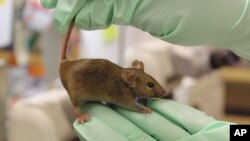Two new studies show that young blood reverses signs of aging in old mice, but that doesn't mean scientists have finally found the elusive fountain of youth.
However, the discovery could one day help people lead healthier lives.
In two papers published in Science, Harvard University researchers in Boston describe how the protein GDF11, found in higher levels in the blood of young mice, improved the brain and muscle function of older mice.
GDF11 appears to work by stimulating the development of new blood vessels. The protein is also present in humans.
In one experiment, researchers increased the levels of GDF11 in aging mice by surgically connecting the circulatory systems of young mice to the old rodents.
Blood containing higher levels of GDF11 flowed through the veins of both animals. In another experiment, they injected the protein into elderly mice. Scientists saw the greatest improvement in function in mice that shared the same blood supply.
Investigators saw the formation of new blood vessels and improved blood flow in older mice, which they say reversed signs of aging in every tissue they looked at.
Researcher Lee Rubin, professor of stem cell and regenerative biology at Harvard's Stem Cell Institute, and his team investigated the effect of GDF11 on brain tissue.
"So, this simple surgery, infusing an old mouse with young blood, actually produced some structural changes in the old brain, making the old brain, in essence, more like [a] young brain," he said. "And some people have used the phrase 'rejuvenating the old brain.' And similar things were observed in other tissues."
Rubin colleague Amy Wagers observed that GDF11 repaired DNA damage associated with aging. In prior experiments with the protein, Wagers and colleagues noted the enlarged, weakened hearts of older mice returned to a more youthful size and beat more efficiently. So-called diastolic heart failure, a fatal condition, is common in aging humans and this research raises hopes the disease may be reversible.
Similarly, Rubin says GDF11 possibly could improve memories for Alzheimer's disease patients or movement for Parkinson's victims. But he says the protein is not a "fountain of youth," and the aim of research is not increasing, but improving life span.
"In other words, even if you did not live more years, at least you could remain healthier for the number of years you do live," he said. "And I think again, what we've shown is functional improvement in ... various different tissues in mice."
In an article in Nature, published simultaneously, researchers at Stanford University in California report blood from young mice improved neural circuits, enhancing learning and memory in older rodents.
Researchers in Massachusetts and California have teamed with biotechnology firms to see whether the findings can be translated to humans. Harvard University's Lee Rubin predicts clinical trials could begin in three to five years.
However, the discovery could one day help people lead healthier lives.
In two papers published in Science, Harvard University researchers in Boston describe how the protein GDF11, found in higher levels in the blood of young mice, improved the brain and muscle function of older mice.
GDF11 appears to work by stimulating the development of new blood vessels. The protein is also present in humans.
In one experiment, researchers increased the levels of GDF11 in aging mice by surgically connecting the circulatory systems of young mice to the old rodents.
Blood containing higher levels of GDF11 flowed through the veins of both animals. In another experiment, they injected the protein into elderly mice. Scientists saw the greatest improvement in function in mice that shared the same blood supply.
Investigators saw the formation of new blood vessels and improved blood flow in older mice, which they say reversed signs of aging in every tissue they looked at.
Researcher Lee Rubin, professor of stem cell and regenerative biology at Harvard's Stem Cell Institute, and his team investigated the effect of GDF11 on brain tissue.
"So, this simple surgery, infusing an old mouse with young blood, actually produced some structural changes in the old brain, making the old brain, in essence, more like [a] young brain," he said. "And some people have used the phrase 'rejuvenating the old brain.' And similar things were observed in other tissues."
Rubin colleague Amy Wagers observed that GDF11 repaired DNA damage associated with aging. In prior experiments with the protein, Wagers and colleagues noted the enlarged, weakened hearts of older mice returned to a more youthful size and beat more efficiently. So-called diastolic heart failure, a fatal condition, is common in aging humans and this research raises hopes the disease may be reversible.
Similarly, Rubin says GDF11 possibly could improve memories for Alzheimer's disease patients or movement for Parkinson's victims. But he says the protein is not a "fountain of youth," and the aim of research is not increasing, but improving life span.
"In other words, even if you did not live more years, at least you could remain healthier for the number of years you do live," he said. "And I think again, what we've shown is functional improvement in ... various different tissues in mice."
In an article in Nature, published simultaneously, researchers at Stanford University in California report blood from young mice improved neural circuits, enhancing learning and memory in older rodents.
Researchers in Massachusetts and California have teamed with biotechnology firms to see whether the findings can be translated to humans. Harvard University's Lee Rubin predicts clinical trials could begin in three to five years.





